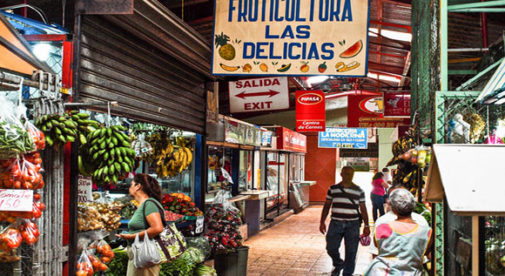Costa Rica doesn’t get much attention as a culinary destination. The national cuisine (known locally as comida tipica) hasn’t extended across borders. And you won’t find Costa Rican restaurants anywhere but Costa Rica. Yet, most tourists and expats find that this country is actually full of some great food. It’s tasty, filling, healthy, and, in most cases, very reasonably priced.
By the way… U.S. chain eateries, as well as international restaurants offering everything from Argentinian-style steak to Italian brick oven pizza to sushi to Spanish tapas and beyond can all be found in Costa Rica, especially in the capital, San José, and its suburbs. And the tourist areas along the Pacific and Caribbean coasts are big on “foreign” restaurants as well.
But let’s focus on what Costa Ricans themselves (and those “gringos” who’ve caught on) typically eat. Below are the top five food specialties that are a must-try when you visit Costa Rica.
Gallo Pinto: Great for Breakfast
This is the breakfast mainstay. And if you favor savory breakfast foods over sweet—this is your dish. It’s simply rice and black beans mixed together with some seasoning and usually sweet red pepper and onion. It’s accompanied by eggs, a corn tortilla, and a good local cheese like turrialba (sort of like a mix of gouda and mozzarella, in my opinion). Of course, good locally-grown Costa Rican coffee is a must for any breakfast. The cost is typically $3 to $4.
An Abundance of Seafood
The waters off Costa Rica’s Pacific and Caribbean coasts are major fishing grounds. And as a result, fresh seafood is abundant in fish markets throughout the country. Corvina, mahi mahi (here called dorado), tuna, snapper…that’s just a small sample of what’s available. I have a few favorite ways I like to enjoy fresh-caught seafood in Costa Rica.
First is ceviche, which is fish “cooked” by citrus juice, usually lemon or lime, and mixed with chopped vegetables like onion or peppers. This tart and flavorful dish didn’t originate in Costa Rica, but the locals have embraced it wholeheartedly. It’s available in most restaurants serving comida tipica, and almost guaranteed to be on the menu of any seaside establishment. On the coasts, roadside stands manned by local fisherman or their families offer great ceviche. My wife and I have also perfected our own ceviche recipe and make it ourselves at home.
Another great way to enjoy seafood in Costa Rica is on the coasts. Small-time fisherman still ply the waters every day, often from the same fishing villages that their fathers and grandfathers fished from. Some of these villages have turned into major expat and tourist destinations. But the fisherman remain as development grows up around them. The bonus is that fresh-off-the-boat tuna, snapper, mahi mahi, and more is available any day year-round. Just head down to the beach when the boats are coming in. Or keep an eye out for the refrigerated truck carrying the catch around to the local restaurants—flag them down on the street. The price can’t be beat. A pound of sushi-grade tuna or mahi mahi will run you about $6.
Casado: The National Dish

But typically, you’ll get rice and black beans (separate, not mixed like gallo pinto), a side salad of lettuce or cabbage, a casserole of potato or squash, sweet plantains, and a main of your choice of chicken, beef, pork, or fish. Some restaurants add avocado slices…others a fried egg. It’s all up to the cook. But any way it comes, it’s delicious.
The best place to enjoy a casado is at a soda, which is a type of unpretentious, basic restaurant found everywhere in Costa Rica, from towns to the remote countryside. It’s kind of like a diner in the U.S.
Other popular rice-based dishes include arroz con pollo (rice with chicken) and arroz con camarones (rice with shrimp).
Caribbean Cuisine in Costa Rica
The Caribbean coast of Costa Rica is a world apart from the rest of the country, in more ways than one. Originally settled by Jamaicans and other Caribbean islanders who came to work on railroad and agriculture projects on this coast a century or more ago, the habitants to this day speak an “island-inflected” English and have a distinct culture from the rest of Costa Rica.
The differences extend to food. Rice is cooked in coconut milk mixed with spices before being served with red beans. Patties filled with spicy meat are popular street food. And the famous rondon seafood soup is worth a trip to the Caribbean coast alone. The base is coconut milk, but spices are added, as well as fresh fish, breadfruit, cassava and other local vegetables. It’s sweet and spicy. The towns of Cahuita and Puerto Viejo de Talamanca are some of the best places to enjoy authentic Afro-Costa Rican cuisine.
What to Drink: Refrescos Naturales
Costa Rica is blessed with an abundance of fresh, tropical fruit. And many of these fruits make their way into refrescos naturales, which are smoothies or juices made from fresh fruit. Typically only one type of fruit is used in each cup. Some of the popular flavors are mora (blackberry); pina (pineapple); cas (a type of passionfruit); tamarindo (tamarind); and guanabana (soursop). The fruit juice is mixed with water or milk and ice.
Whatever your preference, you’ll find that there’s not much in the world that’s more refreshing on a hot day.
When you visit Costa Rica next, be sure to pay close attention to what you eat—and don’t settle for bland fare at tourist places. Local restaurants serve great food at low prices. And the daily catch—bought from a local fisherman—can be a great alternative for an expensive night out.

Get Your Free Costa Rica Report Here:
Learn more about Costa Rica and other countries in our daily postcard e-letter. Simply enter your email address below and we'll send you a FREE REPORT – Costa Rica: The Land of Pura Vida
This special guide covers real estate, retirement and more in Costa Rica and is yours free when you sign up for our IL postcards below.
Related Articles
The Truth About the Cost of Living in the Orosi Valley, Costa Rica
3 Unique Towns for Beachside Living on Costa Rica’s Pacific Coast
Keeping Fit and Making Friends in Costa Rica’s Southern Zone
Upcoming Conferences
Most Popular Products
Panama 101
Portugal 101
Costa Rica 101




